Periodic Rules
Several Property Classes allow for the specification of Periodic Rules, that is, allowing the product designers to specify restrictions on Product Conditions for certain periods of time (For example, monthly, yearly, arrangement lifetime and so on).
Similarly, Periodic Rules can be used to specify transaction rules such as the number and value of withdrawals or disbursements allowed within a specified periods.
Periodic Attribute Class
The periodic attribute classes are defined and released by Temenos in the AA.PERIODIC.ATTRIBUTE.CLASS application. Each of these records is defined for certain AA.PROPERTY.CLASS records.
In addition, users can define additional AA.PERIODIC.ATTRIBUTE.CLASS records on their own apart from the ones released by Temenos.
Periodic Attribute
The user must then define further time constraints around the rules in the AA.PERIODIC.ATTRIBUTE application. Periodic attributes are user definable and it is an instance of the Periodic Attribute Class.
Periodic Attribute controls the attribute values of an arrangement over a period, through Periodic Rules. To achieve this, it is associated to a Product Condition. When associating a Periodic Attribute to a Product Condition:
- Define a comparison value for evaluation
- Define a Break Result and Break Charge (optional feature)
When a Periodic Attribute is successfully associated to a Product Condition, the comparison value is evaluated against a specific value of the arrangement during run time. The result of the comparison can lead to a break result override with(out) charge or error to stop further process based on the condition setup.
Key Attributes of Periodic Attribute
The Periodic Type field defines the frequency or tenor of the rule. The options are:
- Life – Restriction applies for the entire life of an arrangement or arrangement life as a certain product.
- Initial – Restriction applies for an initial period only of an arrangement during its lifetime or the initial period of an arrangement as a certain product.
- Repeating – Restriction applies for a fixed repeating period during either the life of the arrangement or the life of an arrangement as a certain product. For example the restriction may be based on a 12 month calendar period (that is, Jan to Dec) or a three month period starting on the anniversary of the loan.
- Rolling – Restriction applies for a rolling period that ends at the date of a transaction. (For example, the maximum repayment in the last three months)
The Period field is used in calculating the period considered for the restriction check. This should be based on a standard Temenos Transact Period Type allowing a number of days, weeks, months or years to be specified in the following formats.
- nnnD – nnnn days (Calendar)
- nnnW – nnn weeks
- nnnM – nnn months
- nnnY – nnn years
The user cannot input when the Periodic Type field is Life.
The Calendar field defines how the period specified is to be treated relative to either contract dates or calendar period. The options are:
- Calendar – Periods expressed in years are treated as calendar years, that is, 12M means a period of Jan 1st to Dec 31st. Periods expressed in months are from the 1st calendar day of the month. This value is only allowed if Period Type is set to INITIAL or REPEATING.
- The user can leave the field blank, which indicates that the date calculated from Rule Start and Period.
The Rule Start field determines when the rule comes into effect. For some types of product, the restriction applies from the date that the arrangement was agreed. For other types, it is based on the date that the contract is disbursed. The options are:
- Agreement – Effective start Date of the Product
- Start – Date of the first disbursement or First funding in Arrangement; if not disbursed or funded, then the arrangement start date will be taken till it is disbursed or funded.
- Anniversary - Allows the date and month from the field anniversary in Account property class; not valid for Period Type – Life and Initial;
- Arrangement - Allows the start date of the arrangement. Renewals do not reset the rule start date.
- Cooling-off - Allows the cooling date from Term Amount Property as the base date for calculating the periodic restriction. (For example, Cooling period ends on Dec 31, 2010, periodic restriction is set for AMOUNT.INCREASE and the Period is set to one year when Rule Start is set to Cooling-off, then the periodic restriction applies from the end date of cooling period and not from the date of arrangement). Any charges that need to be collected during pre-closure of loan can be controlled using Cooling-off period.
The Rule End field is used to define when the periodic rule ends. Thus, the rule is checked within the defined value in the Rule Start and Rule End fields. The Rule End field can be input only when the value in the Rule Start field is defined and must be set to Agreement or Arrangement or Start. The option available for this field is:
- Cooling-off - The Cooling Period defined in the Term Amount property condition is used to arrive at the rule end for the periodic evaluation.
- For Accounts product line, the account opening date is used as the cooling period when the Rule End field is set to Cooling-off.
- The Periodic Type field must be blank when the Rule End field is defined.
The Restriction field can be used to give a more specific restriction period within the Period specified. By default, the restricted period is the entire calculated Period.
- This can be specified in the format: Start Period to End Period. (For example: 1M–12M)
- This means the restriction period applies from 1st month after the arrangement start date (as defined in ARRANGEMENT.START/PERIOD definition) to 12 months after this date.
- The restriction can be applied from the date calculated from the first period up to but not including the date calculated from the second period.A 12 month fixed period calculated based on 14/5/08 start date with the following Restriction results in:
- Restriction of ‘0M – 1M’ results in 14/5/08 to 13/6/08 inclusive
- Restriction of ‘1M – 12M’ results in 14/6/08 to 13/5/09
The Rule Start Period and Rule End Period defines the commencement and end period of the rule within its validity defined in the Period.
- If the Rule Start field is set to cooling-off
- If the Rule End field is set to cooling-off
The Multi Arrangement field is used to define if the Periodic Rule should be assessed against not just on the arrangement where the rule is specified but also on one or more of its associated arrangements. The association can be one of the below.
- Cra – The system evaluates the rule against all the arrangements that are associated to the Customer Relationship Arrangement (CRA) group.
- Bundle - The system evaluates the rule against all the arrangements that are associated to the bundled arrangements.
- Mcy –The system evaluates the rule against all the active sub-accounts associated to the MCY arrangement.
- Routine - The system evaluates the rule against all the arrangements that are returned by the custom API.
- Routine Arguments
- PERIODIC.ATTRIBUTE - Periodic attribute against which the evaluation should be run
- EFFECTIVE.DATE - Date as on which evaluation is required</p>
- SOURCE.BALANCE.TYPE - Balance type on which the balance is required. This should be valid Balance Type
- PRODUCT.LIST - List of products against which evaluation should be done
- ARR.LIST - Returns the processed Arrangement id
- SOURCE.BALANCE - Returns the Source balance
- ABSOLUTE.FLAG - Returns the absolute flag
If the user does not select any option, the system evaluates the rule only against the arrangement where the rule is specified.
The Satisfied By field defines if it is sufficient for any one of the multi-arrangements to satisfy the rule or if all the associated arrangements must together satisfy the rule. The allowed values are Any and Combined and the user can specify these values only when a value is specified in the Mutli Arrangement field .
When the Satisfied By value is designated as Combined and the Multi Arrangement value is designated as Cra, during Charge assessment or Interest definition, the aggregate (CRA) balance is compared against the Pricing Rules to serve the customer with a preferential credit interest rate (for example, 25 basis point higher than the base rate when the Total Deposit > 50,000 USD). In such instance, system evaluates the Total Deposits maintained by all the customers of the CRA family group and the rule is compared against the aggregate balance.
The AA.PERIODIC.ATTRIBUTE record is linked to a Property Class in the Periodic Attribute field in the appropriate AA.PRD.DES.XXXX record to specify the comparison value that applies for that property condition.
The value to be applied to the periodic attribute is provided into PR.VALUE (For example, the rule for maximum one month decrease is 10,000).
Using Break Result field, the user can specify what action takes place when the rule is broken.
The options are:
- INFORMATION – Records the fact that the rule is broken only
- OVERRIDE – Raises an override
- ERROR – Blocks processing with an error message
- CAP – Applies upper limit cap if the rule is broken
- FLOOR – Applies lower limit floor if the rule broken
When an arrangement is created, the periodic attribute value is available for modification at the arrangement level.
It is possible to apply a negotiation rule and attribute restriction in the same way as any other Property attribute for a periodic attribute. Restrictions and negotiation should be applied to the value associated with the periodic rule.
Rules Based on the Current Balance
The system is capable of processing rules based on current balance or by assessing the balance over a period, which is supported by the balance options, Assessment Period and Current in the Periodic Type field of the AA.PERIOD.ATTRIBUTE table.
To create a minimum balance rule based upon the current balance, the user can use the Minimum Current Balance record in PERIODIC.ATTRIBUTE. For a minimum balance rule evaluated on a daily basis throughout the assessment period (that is, when account must maintain the minimum balance every day in the period), the user can select the Minimum Period Balance record.
User-Defined Attribute Class
This feature enables the banks to define additional AA.PERIODIC.ATTRIBUTE.CLASS records on their own apart from the ones released by Temenos. This facilitates client-specific rules to be defined locally and reduces dependency on core.
The Comparison Type field is a multi-value field, which can hold different comparison type values. Out of these comparison types allowed for the Periodic Attribute Class, one of the comparison type is used in the Periodic Attribute. Likewise, the Type field in AA.PERIODIC.ATTRIBUTE can take values such as Cap, Floor and Balance Type based on the type of Periodic attribute class defined.
The RULE.VAL.RTN field is an existing field in AA.PERIODIC.ATTRIBUTE.CLASS, represents a routine which returns the value for the comparison routine to do the comparison from property record. It should be a valid entry in EB.API file.
User Defined Periodic Attribute Classes would not work without a valid routine input in this field .
Arguments
| Incoming | Description |
|---|---|
| PROPERTY.ID | Property ID to which the rule is attached |
| START.DATE | Start Date for the Rule (Depends on the Period Type and Period Defined in AA.PERIODIC.ATTRIBUTE) |
| END.DATE | End Date for the Rule (Depends on the Period Type and Period Defined in AA.PERIODIC.ATTRIBUTE) |
| CURRENT.DATE | Effective date on which rule is validated(Activity Effective date) |
| BALANCE.TYPE | Balance Type that is to be used for rule validation (Balance Type Defined in BALANCE.TYPE field in Activity Restriction) |
| ACTIVITY.IDS | Activity that is used for Rule Evaluation |
| Return | Description |
|---|---|
| START.VALUE | Value for the attribute on the start date |
| END.VALUE | Value for the attribute on the end date |
A sample record SETTLEMENT of Periodic Attribute Class is shown below with the details such as Property Class as SETTLEMENT and ATTRIBUTE as SETTLE.

Periodic Attribute Classes and Periodic Attributes for Pricing Rules
Pricing Rules functionality supports ruled based pricing. The primary driver for this is based on the periodic attribute class framework, which is used to setup the rules. The system uses periodic rules for Pricing Rules.
The Property Class and Action fields in the AA.PERIODIC.ATTRIBUTE.CLASS table are multi-valued and sub-valued respectively. For instance, Balance Periodic Attribute Class can be used in both Activity Restriction and Pricing Rule Property Classes.
A sample Balance PAC is shown below, which can be used in both Activity Restriction and Pricing Rules.
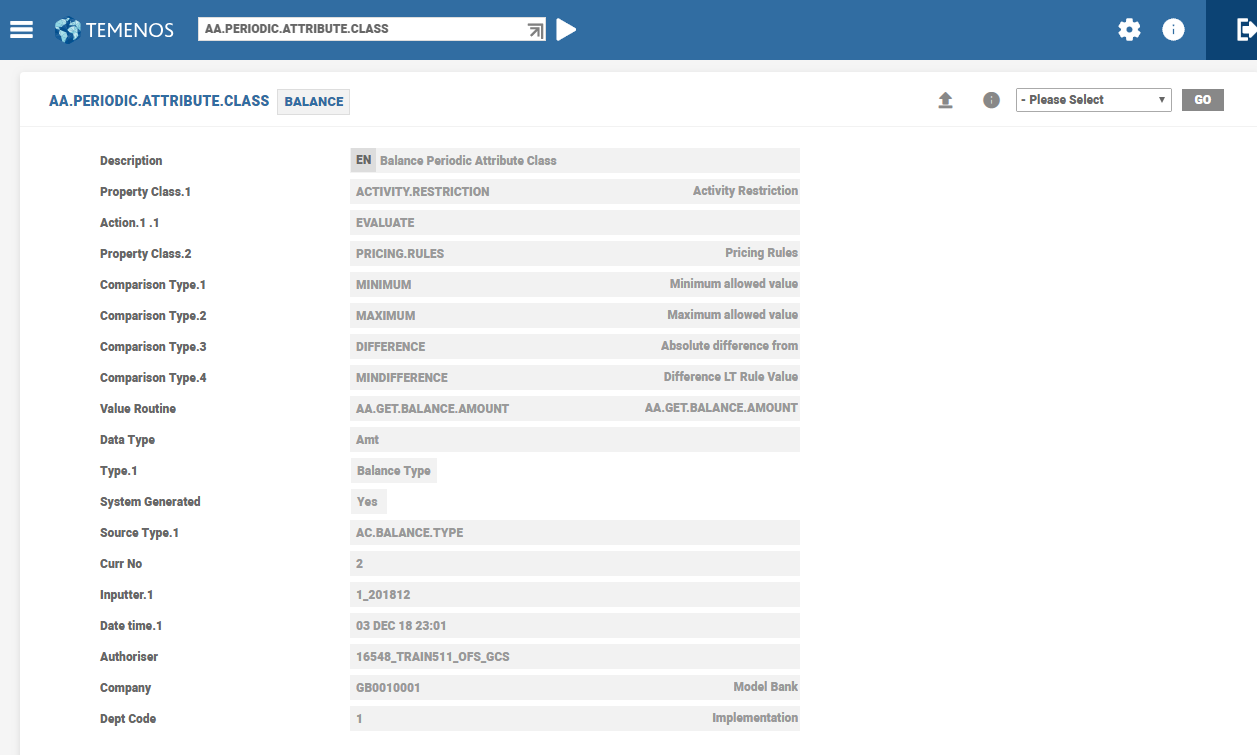
Waive or Reduce Fees based on Age or Customer Segment
Pricing benefits can be setup based on Customer Age and Target using two new periodic attribute class by using them in Pricing Rules for providing discounts.
The Age Periodic Attribute Class is used in Pricing Rules and Activity Restriction for rule evaluation.
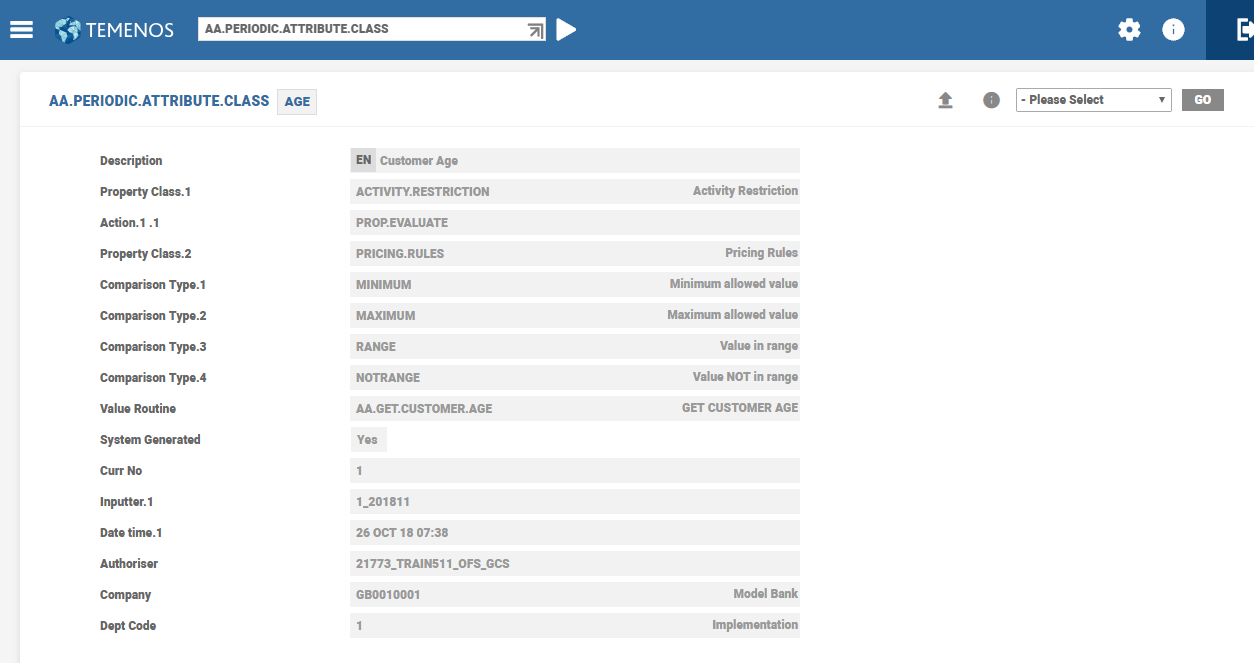
The system returns the age of the customer based on the Date Of Birth field in Customer record. In case of joint accounts, the first beneficial owner (customer) is considered for evaluation.
There are two Periodic Attributes for setting up rules based on Minimum and Maximum Age, which are represented below.
A sample screenshot of Minimum Age is shown below.
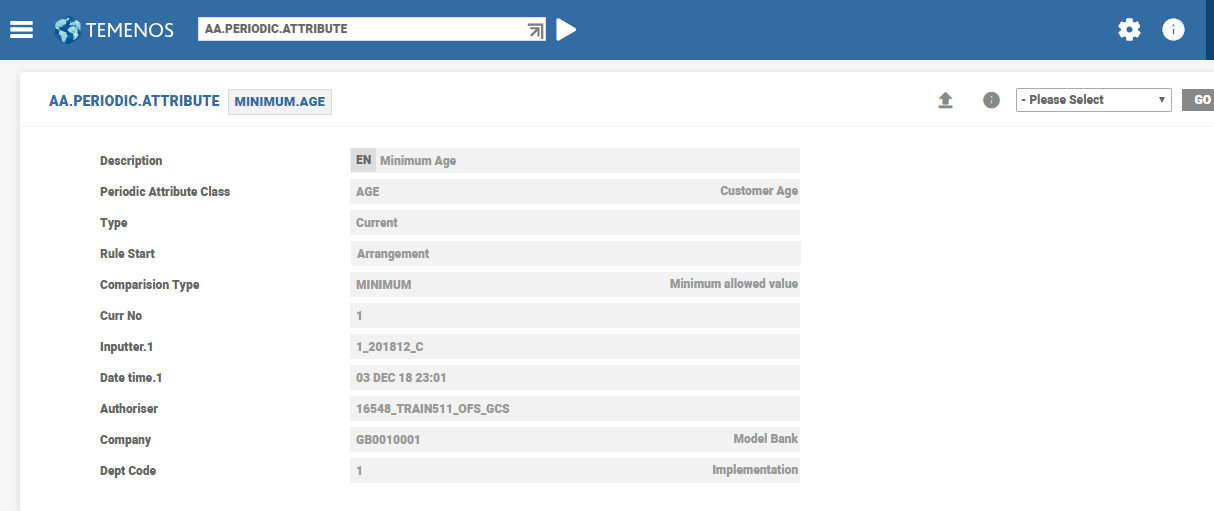
A sample screenshot of Maximum Age is shown below.
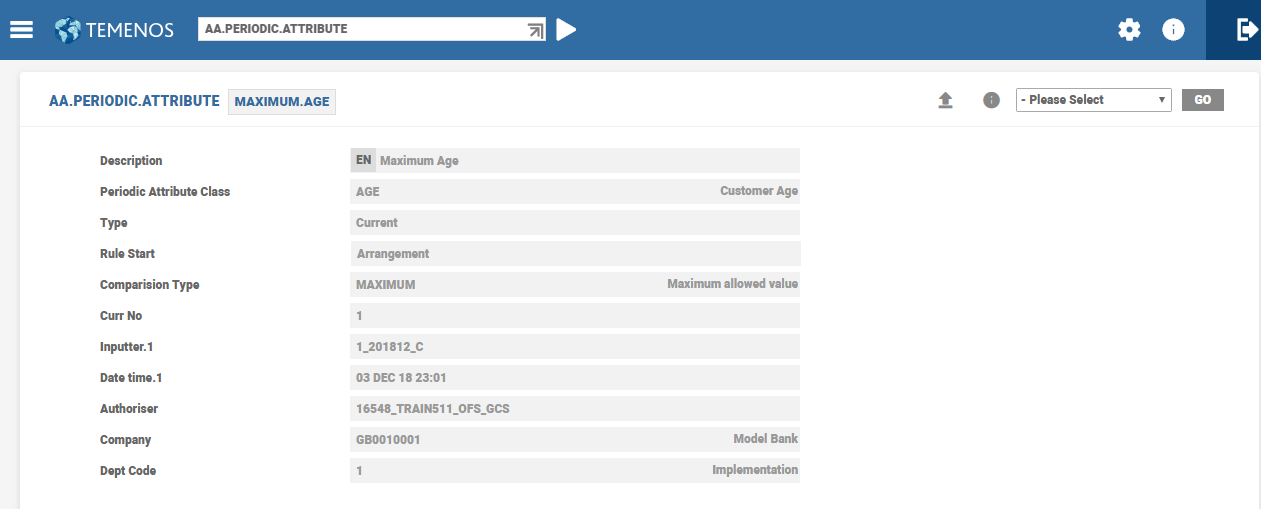
The Target Periodic Attribute Class is used in Pricing Rules and Activity Restriction for rule evaluation. Target is a single value and customer level field (that is, not multi-value field).
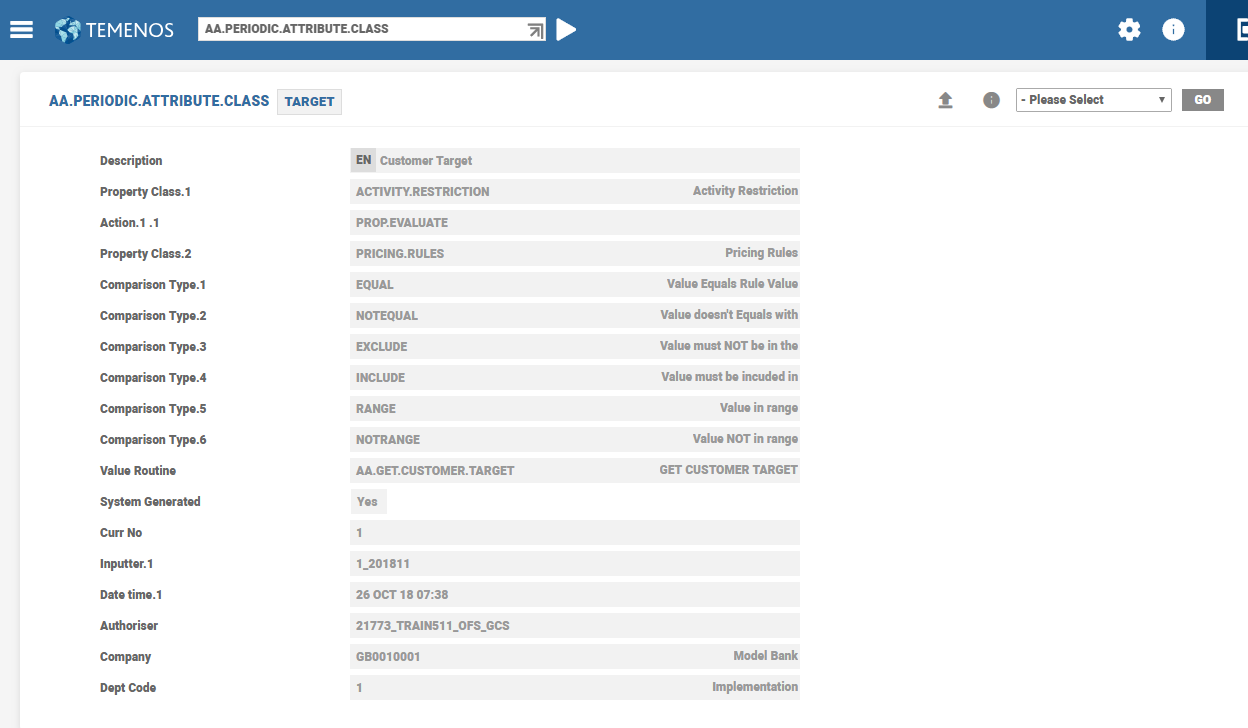
The target customer is chosen based on the Target field in the Customer record. In case of joint accounts, the first customer with beneficial owner role is used for evaluation.
The periodic attributes pertaining to Target namely, Target Periodic , Target List Periodic and Target Range Periodic attributes are shown below.
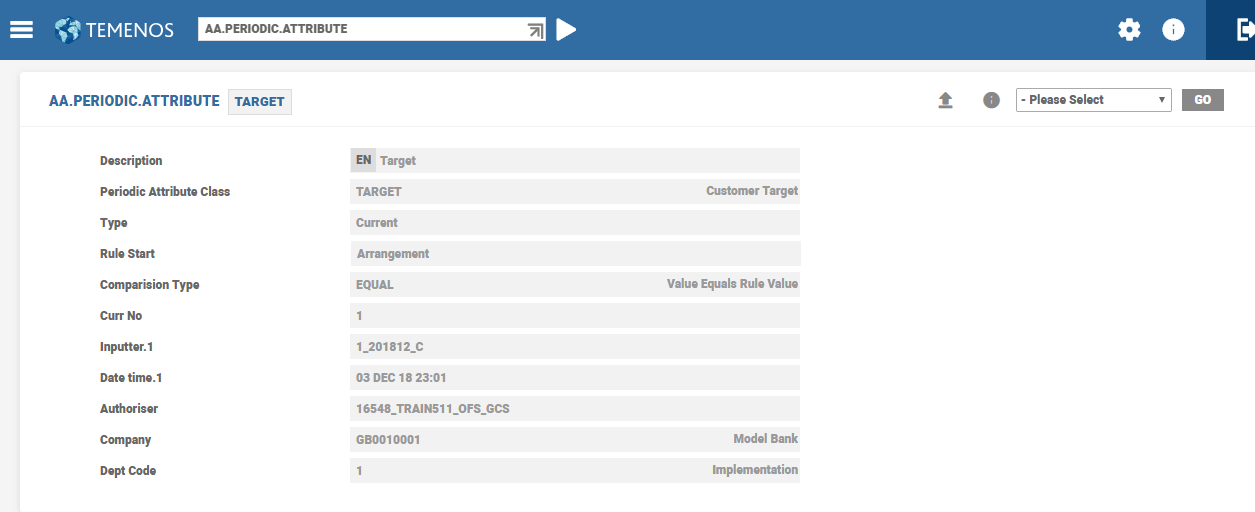
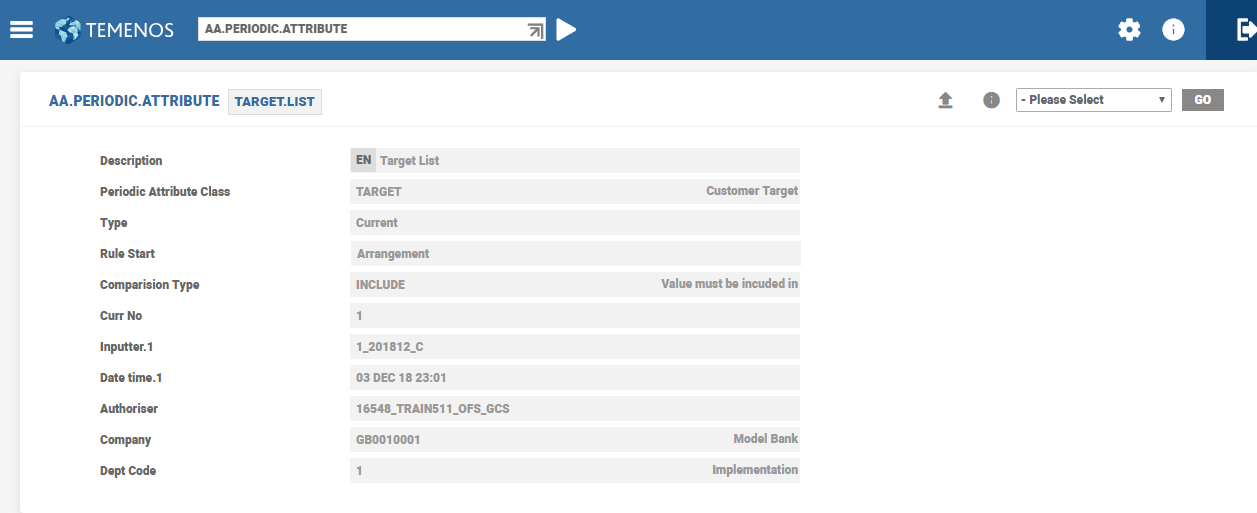
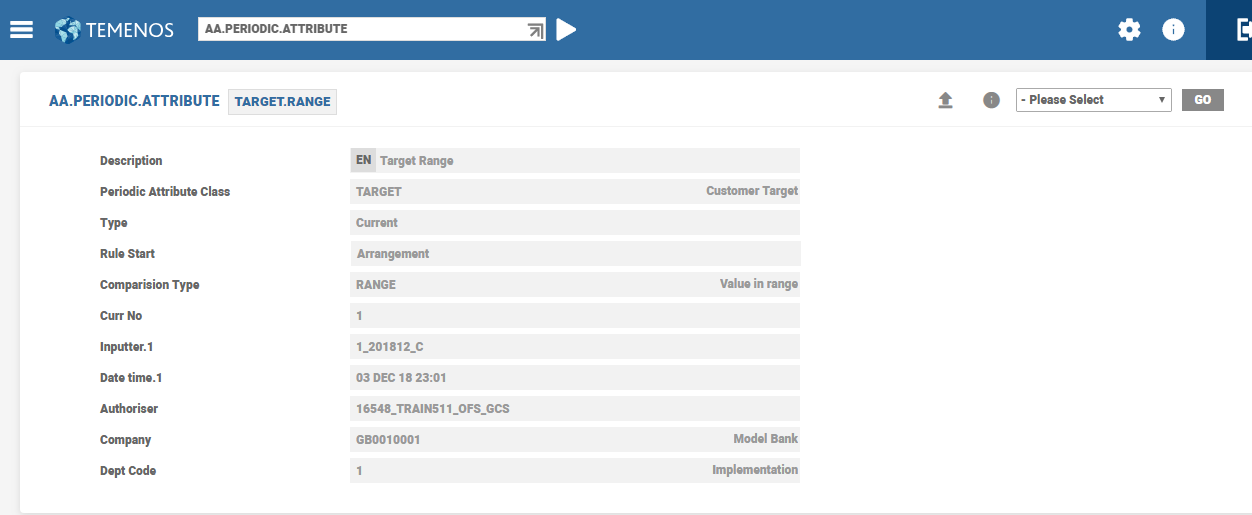
Periodic Attributes for Dormant Accounts
To waive charges when an account is dormant, dormancy status based Periodic Attribute Class and Periodic Attribute are available for Pricing Rules and Activity Restriction. Rules using these attributes can be used to withdraw any benefits or charges that are being levied on the account.
Periodic Attribute Class of Dormancy Status is shown below.
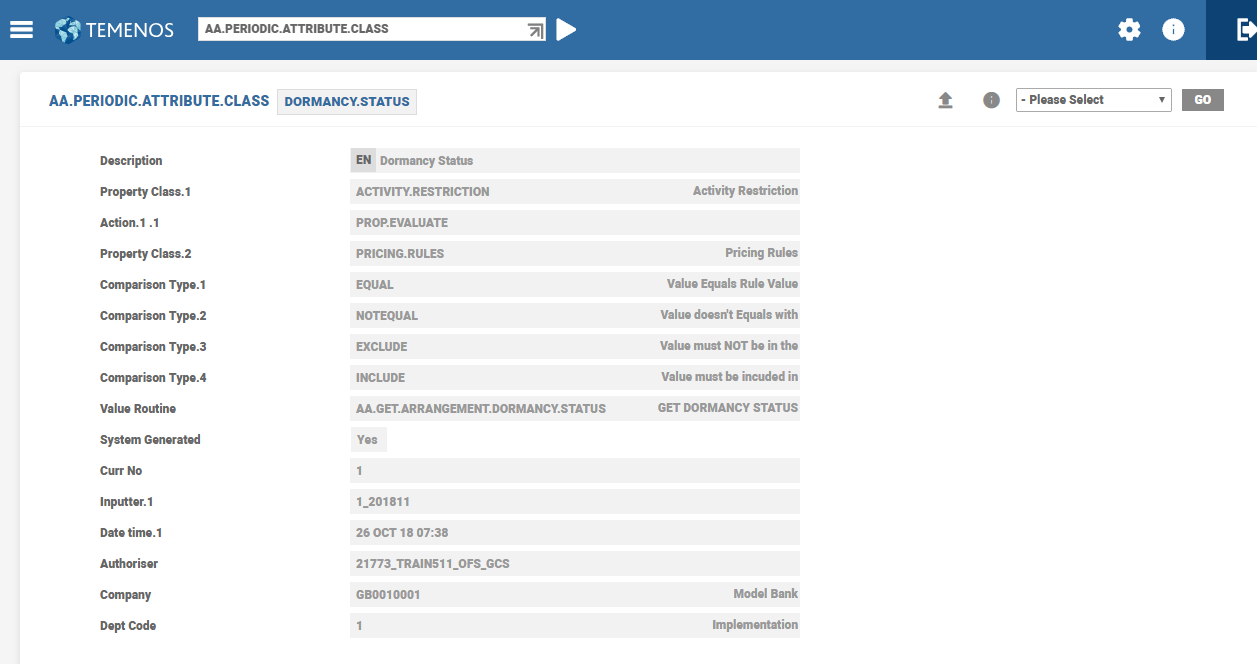
Periodic Attribute of Dormancy Status is shown below.
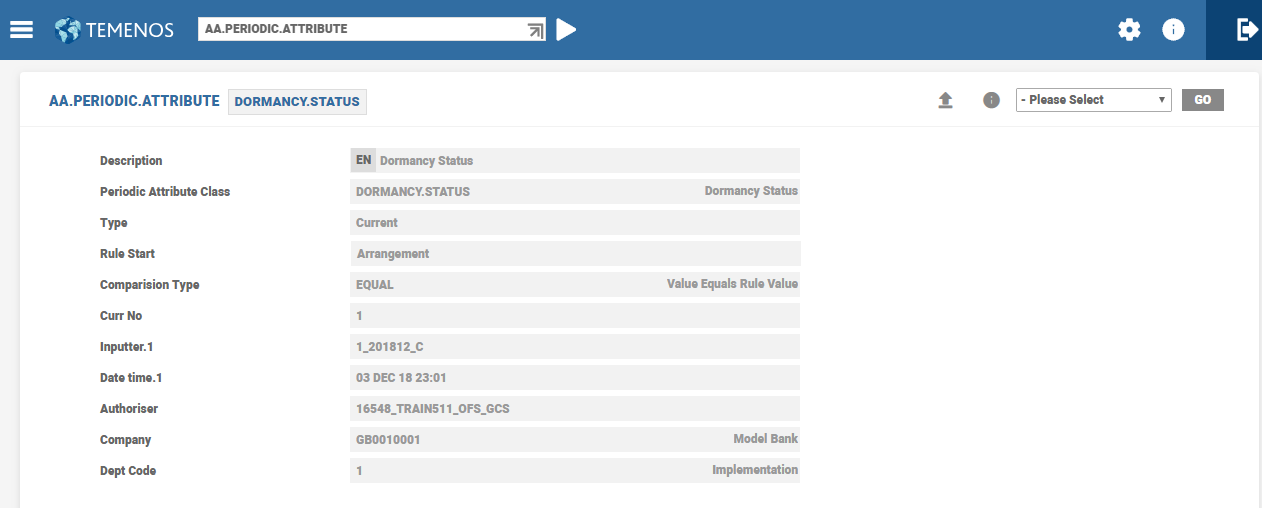
The Dormancy based periodic attribute class returns the dormancy status of the arrangement.
Source Type in Periodic Attribute Class
The Source Type field indicates mark the source for processing (For example, balance needs a balance type and transaction amount needs either Activity Classes or Activities). A source can be a Temenos Transact table or a dynamic table (that is, created in EB Lookup).
Balance Type Used in Rules Criteria
The ACCOUNT.PARAMETER application allows configuration of the System in such way that for some products, Temenos Transact stores the value date balance for assessing interest and calculating charges. Some of them stores the exposure dated balance.
Products in which the Float needs to be taken into consideration, interest and / or charges are configured to use an exposure date. Products in which the Float needs to be ignored considers the value dated setup.
BALANCE record of Periodic Attribute Class is shown below.

TRANSACTION.AMOUNT record of Periodic Attribute Class is shown below.
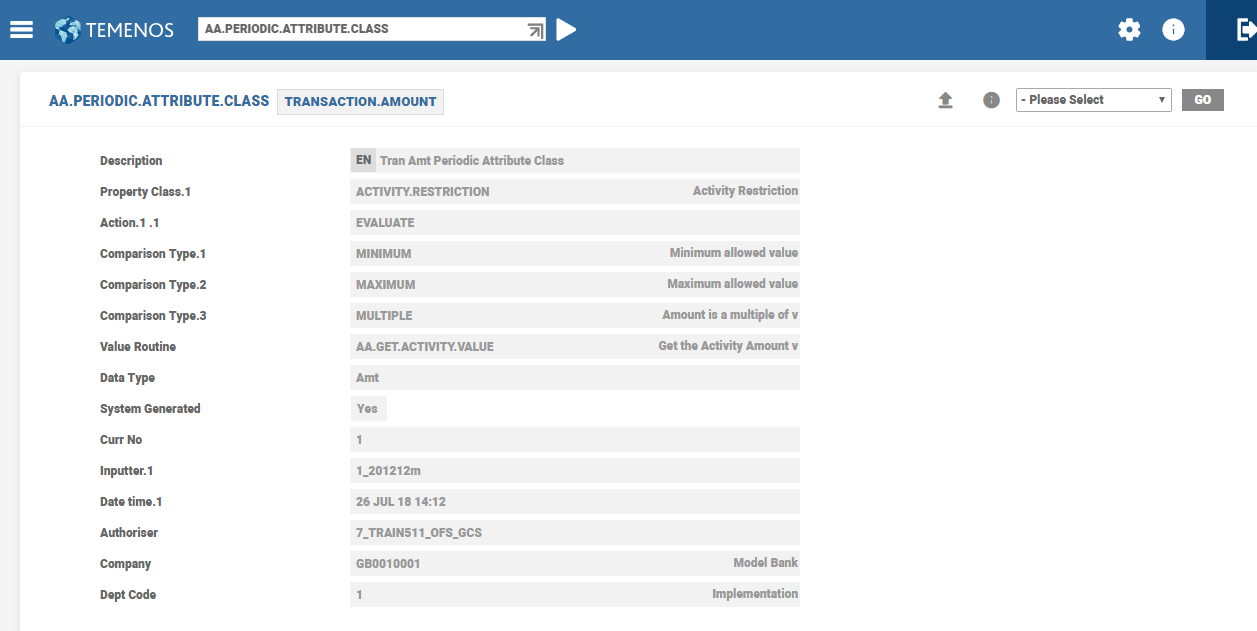
In case of multiple source types (as shown below), the actual source type to be used is specified within the Periodic Attribute record. If none is specified, the system considers the first source type as default and use it for validation and processing of a rule.
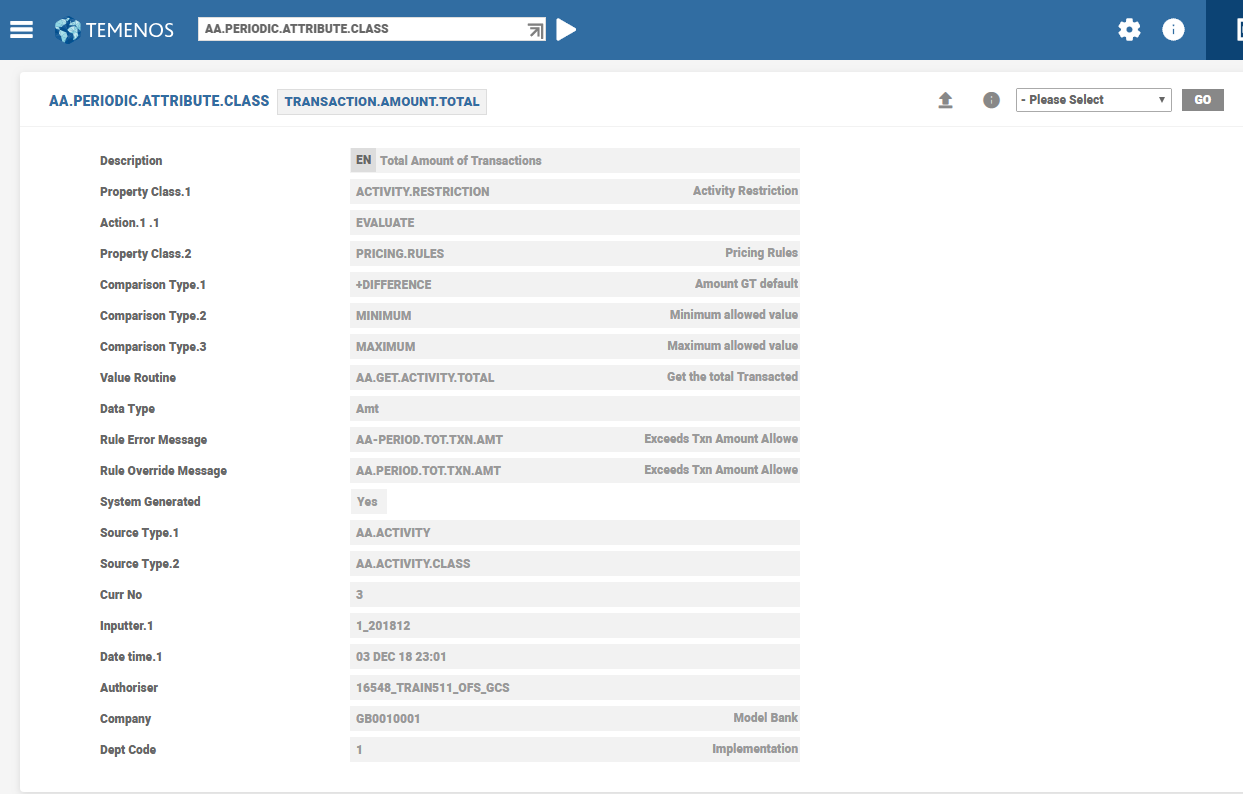
In this topic